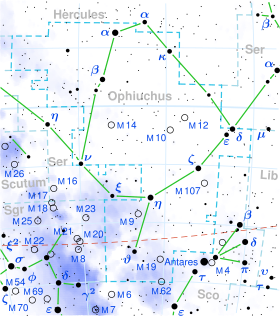| Observation data Epoch J2000 Equinox J2000 | |
|---|---|
| Constellation | Ophiuchus |
| Right ascension | 16h 27m 48.18720s[1] |
| Declination | −8° 22′ 18.2245″[1] |
| Apparent magnitude (V) | 4.62[2] |
| Characteristics | |
| Spectral type | kA2hA5VmA5[3] |
| U−B color index | +0.06[4] |
| B−V color index | +0.16[4] |
| Astrometry | |
| Radial velocity (Rv) | −30.60[5] km/s |
| Proper motion (μ) | RA: −67.49[1] mas/yr Dec.: −11.75[1] mas/yr |
| Parallax (π) | 24.42 ± 0.91 mas[1] |
| Distance | 134 ± 5 ly (41 ± 2 pc) |
| Absolute magnitude (MV) | 1.75[2] |
| Orbit[6] | |
| Primary | Aa |
| Companion | Ab |
| Period (P) | 27.218±0.0005 d |
| Semi-major axis (a) | ≥ 0.0583 AU |
| Eccentricity (e) | 0.744±0.002 |
| Periastron epoch (T) | 2,438,914.84±0.01 JD |
| Argument of periastron (ω) (secondary) | 333.7±0.7° |
| Semi-amplitude (K1) (primary) | 34.9±0.3 km/s |
| Semi-amplitude (K2) (secondary) | 41.1±0.3 km/s |
| Orbit[7] | |
| Primary | A |
| Companion | B |
| Period (P) | 82.8±1.4 yr |
| Semi-major axis (a) | 0.79±0.03″ |
| Eccentricity (e) | 0.45±0.03 |
| Inclination (i) | 31.2±5.7° |
| Longitude of the node (Ω) | 86.8±6.9° |
| Periastron epoch (T) | B 1994.1±1.0 |
| Argument of periastron (ω) (secondary) | 177.9±7.4° |
| Details | |
| Mass | 1.94[8] M☉ |
| Radius | 1.9[8] R☉ |
| Luminosity | 16.56[2] L☉ |
| Surface gravity (log g) | 4.45[9] cgs |
| Temperature | 8,364[9] K |
| Metallicity [Fe/H] | +0.14[2] dex |
| Rotational velocity (v sin i) | 44[10] km/s |
| Other designations | |
| Database references | |
| SIMBAD | data |
Upsilon Ophiuchi is a triple star[12] system in the equatorial constellation of Ophiuchus. It has a white hue and is faintly visible to the naked eye with an apparent visual magnitude of 4.62.[2] The distance to this system is approximately 134 light years based on parallax.[1] It is drifting closer with a radial velocity of −30.6 km/s.[5]
The variable radial velocity of the brighter component was first observed by H. A. Abt in 1961. It is a double-lined spectroscopic binary system with an orbital period of 27.2 days and an eccentricity of 0.74.[6] They have a combined magnitude of 4.71. Both components are similar stars with a combined stellar classification of kA2hA5VmA5, and one or both are Am stars.[3] The third component has an 82.8 year orbit with the inner pair at an eccentricity of 0.45.[7] The system is a source for X-ray emission.[13]
- ^ a b c d e f Cite error: The named reference
vanLeeuwen2007was invoked but never defined (see the help page). - ^ a b c d e Cite error: The named reference
XHIPwas invoked but never defined (see the help page). - ^ a b Cite error: The named reference
abt1995was invoked but never defined (see the help page). - ^ a b Cite error: The named reference
Mallama2014was invoked but never defined (see the help page). - ^ a b Cite error: The named reference
Wilson1953was invoked but never defined (see the help page). - ^ a b Cite error: The named reference
Gutman1965was invoked but never defined (see the help page). - ^ a b Cite error: The named reference
ORB6was invoked but never defined (see the help page). - ^ a b Cite error: The named reference
AllendePrietowas invoked but never defined (see the help page). - ^ a b Cite error: The named reference
David2015was invoked but never defined (see the help page). - ^ Cite error: The named reference
Hoffleit1991was invoked but never defined (see the help page). - ^ Cite error: The named reference
SIMBADwas invoked but never defined (see the help page). - ^ Cite error: The named reference
Eggleton2008was invoked but never defined (see the help page). - ^ Cite error: The named reference
Schröder2007was invoked but never defined (see the help page).
